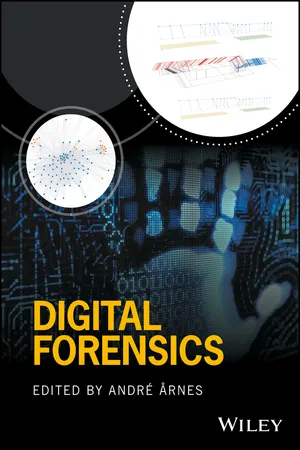Digital Forensics
About this book
The definitive text for students of digital forensics, as well as professionals looking to deepen their understanding of an increasingly critical field
Written by faculty members and associates of the world-renowned Norwegian Information Security Laboratory (NisLab) at the Norwegian University of Science and Technology (NTNU), this textbook takes a scientific approach to digital forensics ideally suited for university courses in digital forensics and information security. Each chapter was written by an accomplished expert in his or her field, many of them with extensive experience in law enforcement and industry. The author team comprises experts in digital forensics, cybercrime law, information security and related areas.
Digital forensics is a key competency in meeting the growing risks of cybercrime, as well as for criminal investigation generally. Considering the astonishing pace at which new information technology – and new ways of exploiting information technology – is brought on line, researchers and practitioners regularly face new technical challenges, forcing them to continuously upgrade their investigatory skills. Designed to prepare the next generation to rise to those challenges, the material contained in Digital Forensics has been tested and refined by use in both graduate and undergraduate programs and subjected to formal evaluations for more than ten years.
- Encompasses all aspects of the field, including methodological, scientific, technical and legal matters
- Based on the latest research, it provides novel insights for students, including an informed look at the future of digital forensics
- Includes test questions from actual exam sets, multiple choice questions suitable for online use and numerous visuals, illustrations and case example images
- Features real-word examples and scenarios, including court cases and technical problems, as well as a rich library of academic references and references to online media
Digital Forensics is an excellent introductory text for programs in computer science and computer engineering and for master degree programs in military and police education. It is also a valuable reference for legal practitioners, police officers, investigators, and forensic practitioners seeking to gain a deeper understanding of digital forensics and cybercrime.
Frequently asked questions
- Essential is ideal for learners and professionals who enjoy exploring a wide range of subjects. Access the Essential Library with 800,000+ trusted titles and best-sellers across business, personal growth, and the humanities. Includes unlimited reading time and Standard Read Aloud voice.
- Complete: Perfect for advanced learners and researchers needing full, unrestricted access. Unlock 1.4M+ books across hundreds of subjects, including academic and specialized titles. The Complete Plan also includes advanced features like Premium Read Aloud and Research Assistant.
Please note we cannot support devices running on iOS 13 and Android 7 or earlier. Learn more about using the app.
Information
1
Introduction
1.1 Forensic Science
Definition 1.1: Forensic Science
1.1.1 History of Forensic Science
- Mathieu Orfila (1787–1853), considered the father of forensic toxicology, published the first scientific text on forensic toxicology in 1814.
- Alphonse Bertillon (1853–1914) developed a method for identification through body measurements and published a system on personal identification in 1879.
- Francis Galton (1822–1911) studied fingerprints as a means of identification and published the book Finger Prints in 1892.
- Hans Gross (1847–1915) established the principles for the application of science in investigations in several publications, the first one in 1893.
- Alberts S. Osborn (1858–1946) established scientific principles for document examination and published the book Questioned Documents in 1910.
- Leone Lattes (1887–1954) studied characteristics of blood types for identification and created a method for the analysis of blood groups in blood stains in 1915.
- Edmond Locard (1877–1966), recognized worldwide for promoting the scientific method in criminal investigation, established a police laboratory in Lyon in 1910.
1.1.2 Locard's Exchange Principle
Definition 1.2: Locard's Exchange Principle
1.1.3 Crime Reconstruction
Definition 1.3: Crime Reconstruction
1.1.4 Investigations
Table of contents
- Cover
- Title Page
- Copyright
- Preface
- List of Contributors
- List of Figures
- List of Tables
- List of Examples
- List of Definitions
- List of Abbreviations
- Chapter 1: Introduction
- Chapter 2: The Digital Forensics Process
- Chapter 3: Cybercrime Law
- Chapter 4: Digital Forensic Readiness
- Chapter 5: Computer Forensics
- Chapter 6: Mobile and Embedded Forensics
- Chapter 7: Internet Forensics
- Chapter 8: Challenges in Digital Forensics
- Chapter 9: Educational Guide
- References
- Index
- End User License Agreement
